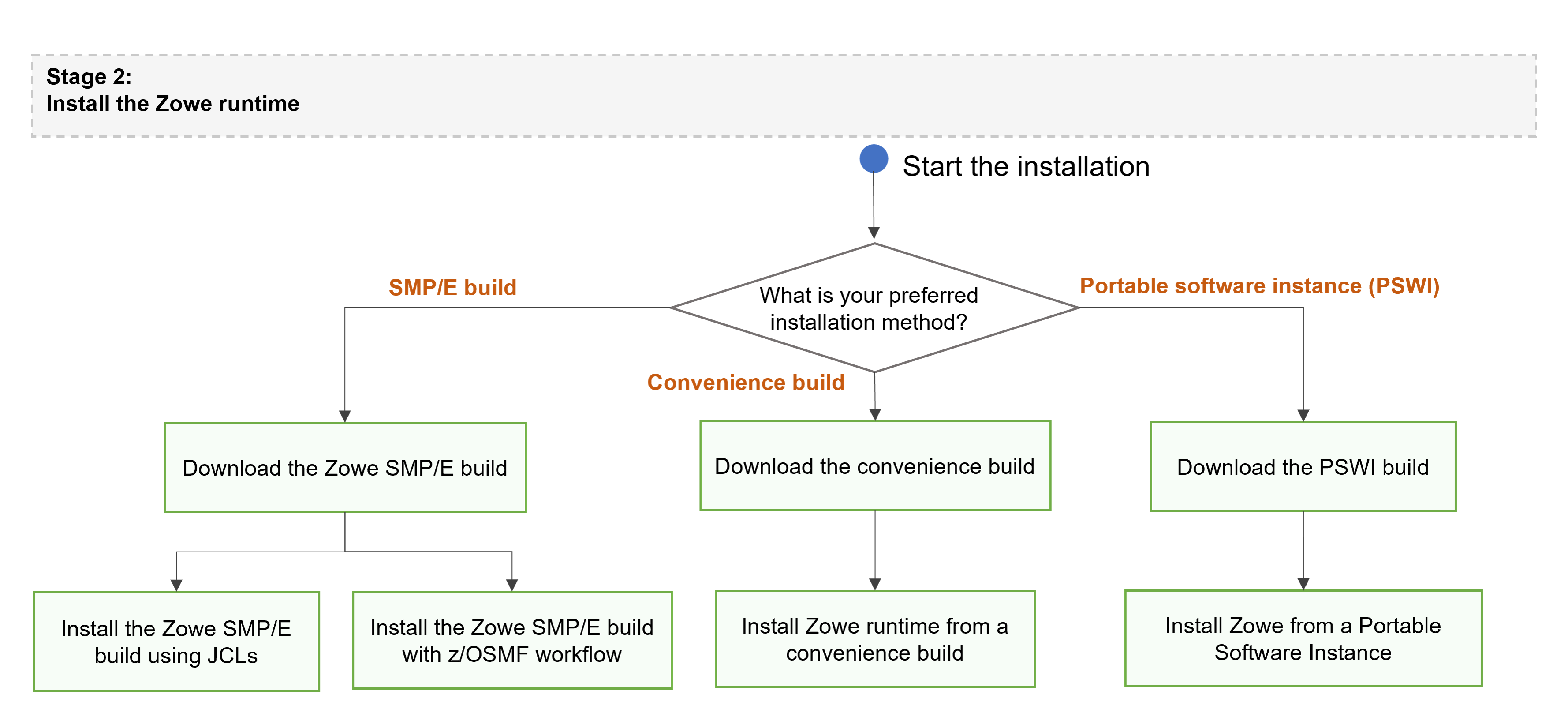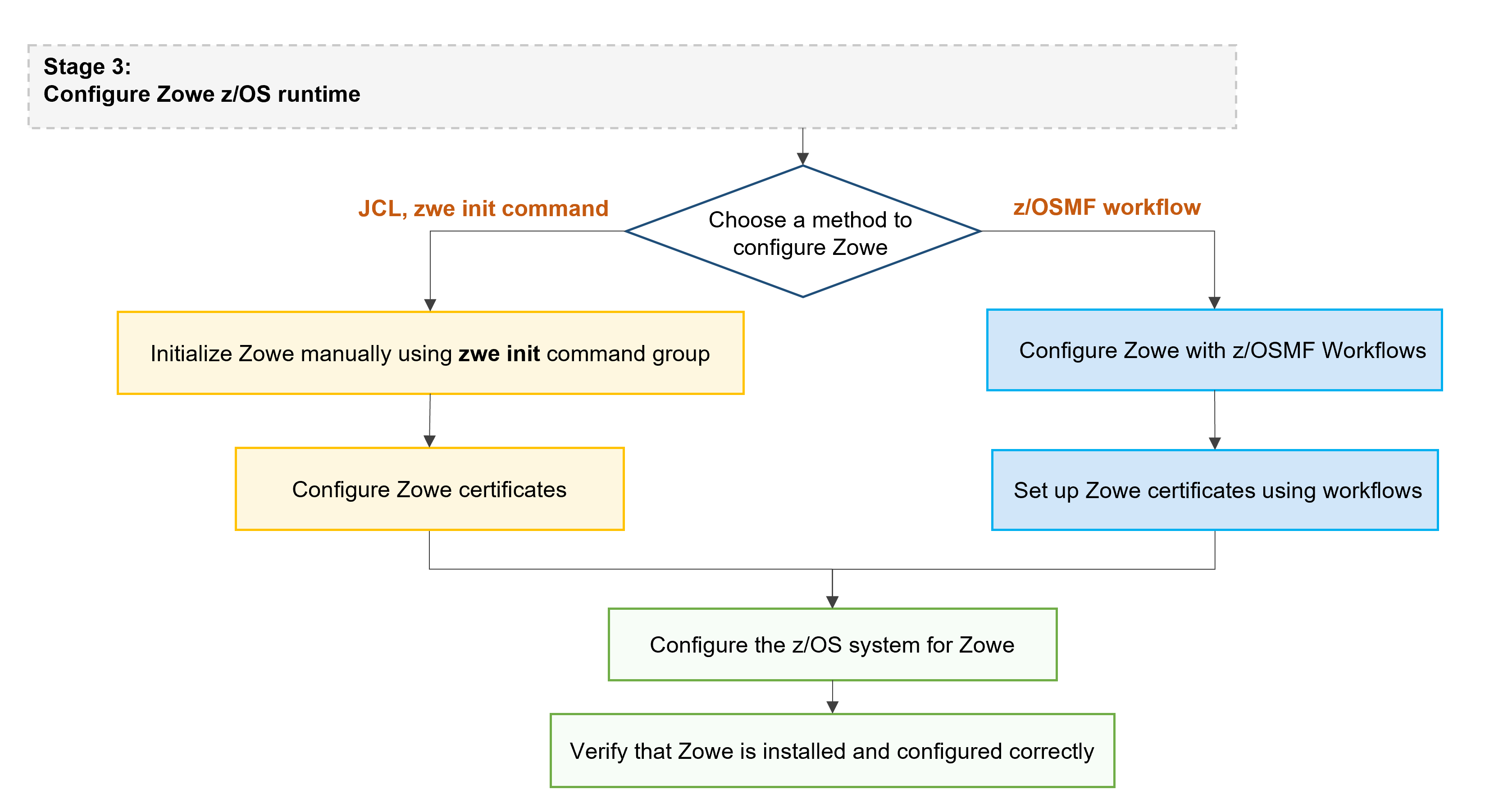Zowe server-side installation overview
Zowe server-side installation overview
When you install Zowe™ on z/OS, you install the following two parts:
-
The Zowe runtime, which consists of a number of components including:
- Zowe Application Framework
- Zowe API Mediation Layer
- Z Secure Services (ZSS)
-
The Zowe Cross Memory Server, also known as ZIS, which is an APF authorized server application that provides privileged services to Zowe in a secure manner.
Zowe provides the ability for some of its unix components to be run not under USS, but as a container, see Installing Zowe Containers.
If you want to configure Zowe for high availability, see High Availability overview for instructions.
Stage 1: Planning and preparing
Before continuing with the installation, you should be familiar with the following topics:
- Zowe's hardware and software requirements
- The
zweutility used for installing, configuring, and managing Zowe - The configuration file used for Zowe,
zowe.yaml
These topics and more are covered in the Planning the installation page.
Stage 2: Installing the Zowe z/OS runtime

-
Ensure that the software requirements are met. The prerequisites are described in System requirements.
-
Choose the method of installing Zowe on z/OS.
The Zowe z/OS binaries are distributed in the following formats. They contain the same contents but you install them by using different methods. You can choose which method to use depending on your needs.
-
Convenience build
The Zowe z/OS binaries are packaged as a PAX file which is a full product install. Transfer this to a USS directory and expand its contents. Using the zwe command
zwe installwill extract a number of PDS members contain load modules, JCL scripts, and PARMLIB entries. -
SMP/E build
The Zowe z/OS binaries are packaged as the following files that you can download. You install this build through SMP/E.
- A pax.Z file, which contains an archive (compressed copy) of the FMIDs to be installed.
- A readme file, which contains a sample job to decompress the pax.Z file, transform it into a format that SMP/E can process, and invoke SMP/E to extract and expand the compressed SMP/E input data sets.
-
Portable Software Instance (PSWI)
You can acquire and install the Zowe z/OS PAX file as a portable software instance (PSWI) using z/OSMF.
While the procedures to obtain and install the convenience build, SMP/E build or PSWI are different, the procedure to configure a Zowe runtime is the same irrespective of how the build is obtained and installed.
-
-
Obtain and install the Zowe build.
- For how to obtain the convenience build and install it, see Installing Zowe runtime from a convenience build.
- For how to obtain the SMP/E build and install it, see Installing Zowe SMP/E.
- For how to obtain the PSWI and install it, see Installing Zowe from a Portable Software Instance.
After successful installation of either a convenience build or an SMP/E build, there will be a zFS folder that contains the unconfigured Zowe runtime directory, a utility library SZWEEXEC that contains utilities, a SAMPLIB library SZWESAMP that contains sample members, and a load library SZWEAUTH that contains load modules. The steps to prepare the z/OS environment to launch Zowe are the same irrespective of the installation method.
Stage 3: Configuring the Zowe z/OS runtime

You can configure the Zowe runtime with one of the following methods depending on your needs.
We recommend you open the links to this configuration procedure in new tabs.
Whether you have obtained Zowe from a .pax convenience build, or an SMP/E distribution, the steps to initialize the system are the same.
The zwe init command runs the subcommands in sequence automatically. You can choose to run the subcommands one by one to define each step based on your need, or if you encounter some failures with zwe init command, you can pick up the failed subcommands step specifically and rerun it.
-
Prepare zowe.yaml configuration file if the file does not already exist.
-
Prepare custom MVS data sets. Copy the data sets provided with Zowe to custom data sets. (
zwe init mvs) -
(Required only if you are configuring Zowe for cross LPAR sysplex high availability): Create the VSAM data sets used by the Zowe API Mediation Layer caching service. (
zwe init vsam) -
APF authorize load libraries containing the modules that need to perform z/OS priviledged security calls.. (
zwe init apfauth) -
Initialize Zowe security configurations. Create the user IDs and security manager settings. (
zwe init security)If Zowe has already been launched on a z/OS system from a previous release of Zowe v2 you can skip this security configuration step unless told otherwise in the release documentation.
-
Configure Zowe to use TLS certificates. (
zwe init certificate) -
Install Zowe main started tasks. (
zwe init stc) -
Verify the installation. Verify that Zowe is installed correctly on z/OS.
- For testing purposes, it is not necessary to set up certificates when configuring the API Mediation Layer. You can configure Zowe without certificate setup and run Zowe with
verifyCertificates: DISABLED. - For production environments, certificate are required. Ensure that certificates for each of the following services are issued by the Certificate Authority (CA) and that all keyrings contain the public part of the certificate for the relevant CA.
- z/OSMF
- Zowe
- The service that is onboarded to Zowe
Stage 4: (Optional) Customizing the configuration
Now that you have the permissions, certificates, tasks, files and datasets necessary to run Zowe, you may want to customize your Zowe configuration. Through customization, you can change attributes such as:
- Enabling or disabling components so you only run what you need.
- Changing the network ports Zowe runs on to suit your environment.
- Customizing the behavior of a component, such as turning on optional features or logging
It's recommended that the first customization you do is to set zwe to use the Configuration Manager
Many other customization options can be found in Zowe YAML configuration file reference.
Stage 5: (Optional) Installing and managing extensions
You should start zowe for the first time before installing extensions.
After it is customized based on your needs, you can get more value from Zowe through installing extensions, whether they are optional components from the Zowe project or from other vendors.
You can learn how to install and manage extensions here
Looking for troubleshooting help?
If you encounter unexpected behavior when installing or verifying the Zowe runtime on z/OS, see the Troubleshooting section for tips.
If you need more information on zwe check the zwe appendix
If you need more information on the server configuration file, check the Zowe YAML configuration file reference.